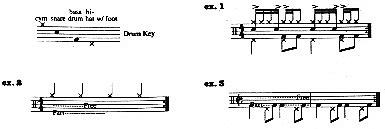Welcome to PaulWertico.com!
A Different Kind Of Independence
It's probably an accurate statement, if not too obvious, to say that the more independence drummers have, the more creative we can be. That explains why we all constantly practice exercises that were designed solely for learning independence, or learn new beats and grooves, which is a more musical and fun way to accomplish pretty much the same thing. This article will present an alternative way of getting a useful, but specialized type of independence that can really open up some new avenues of expression for you.
Most independence books train the drummer to be able to play any number of different rhythms simultaneously with each limb. These rhythms usually fall in time together, so that when you look at the exercise, you can easily see which notes fall together, which notes fall by themselves, and which limb to use for each part. See Ex. 1.

In this column we're going to work on another kind of independence in which one or more limbs plays a repetitive pattern, while the others play free. It is as much an independence of the mind, as it is the limbs. One has to master a number of things to accomplish this: You have to keep the time firmly planted in your head; sustain the time accurately, both in the placement of your limbs and their articulation; and perform an interesting and musical free counterpoint. This can really open up some doors, since it is true independence, not just learned exercises.
In Ex. 2 we have the hands playing independently. The right plays quarter notes on the ride cymbal, while the left plays in and out of time on the snare. I strongly suggest you use a metronome or drum machine when doing this, to make sure that the quarter notes are accurate. Start with just the right hand. Make sure the sound is consistent in both dynamics and timbre. Once you feel that you're really locked into the groove, begin playing on the snare with your left hand. At first you might try rhythms with which you're already comfortable. Next, try dropping the stick onto the head, and letting it bounce. Then try patterns that almost seem to fight the time of the ride cymbal. Finally, try playing in and out of time, doing accelerandos and decelerandos. However, don't play sloppily. Make certain that what you play on the snare drum sounds believable. Try to get to the point where you sound like two separate drummers, not just one drummer with a bad left hand.
Look at Ex. 3. Here is a musical effect that I use from time to time when soloing. The feet are playing a typical samba pattern, while the hands are playing free. I really love to do this, especially over some kind of a rhythmic vamp, since it creates a lot of musical tension. You can see that the approach is similar to Ex. 2. Get your feet locked into the groove and just go for it. It's an incredible feeling when you can play anything you can think of, while your feet maintain their own independent patterns. You can also try just playing 2 and 4 on the hi-hat, and play in and out of the time with your hands and right foot. It's a great solo tool when playing jazz.
The number of repetitive parts you can invent is infinite, so use your creativity. Once you get used to practicing this way, you'll automatically come up with great variations and discover a world of rhythmic ideas and effects.
Images and Information from DRUM! March/April 1993, pages 43 & 44